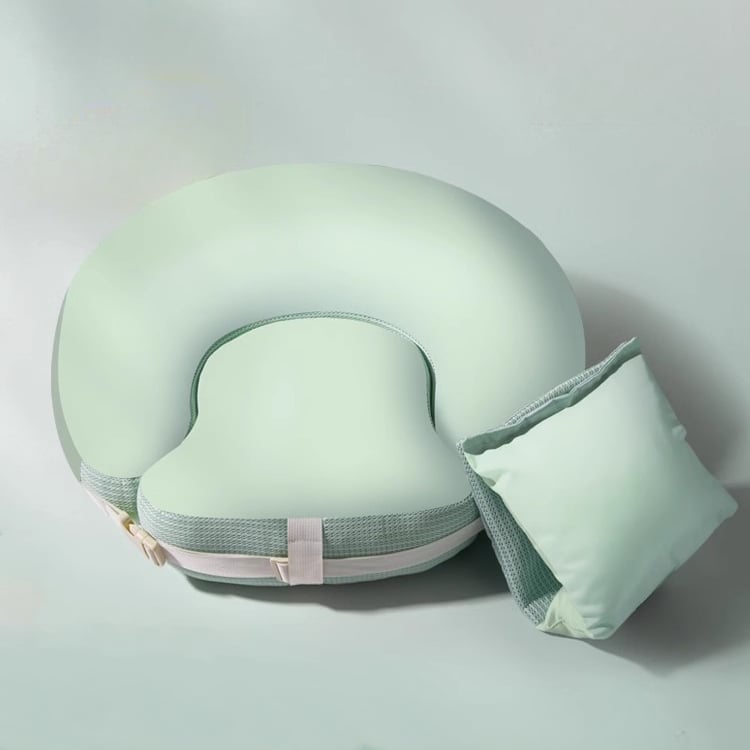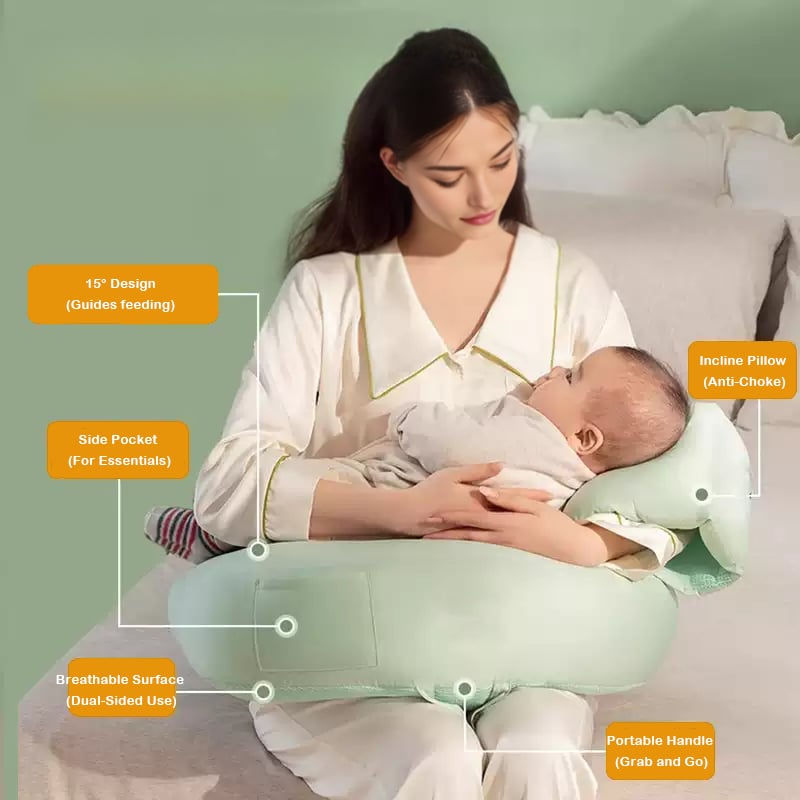
The Ultimate Guide to Breastfeeding Posture: Correcting 4 Common Mistakes + Scientific Support Plan
—— Say Goodbye to Back Pain and Easily Achieve Deep Latching
1. Shoulder Posture: From “Forced Latch” to “Guiding Self-Latching”

❌ Incorrect Approach
Hunching and forcing the nipple into the baby’s mouth leads to:
- Stiff shoulders and neck pain for the mother, resulting in headaches.
- The baby, startled by the sudden motion, latches shallowly (only nipple), increasing the risk of nipple soreness.
✅ Scientific Adjustment
Before Feeding:
- Stretch your shoulders and back: Interlace your hands behind your back, slowly lift upwards and hold for 10 seconds (repeat 3 times).
- Stable sitting posture: Your back should lightly touch the chair back, feet flat on the floor, pelvis slightly tilted forward.
Guiding the Baby to Self-Latch:
- Touch the baby’s nose with your nipple → move to their upper lip → once the baby opens their mouth wide, quickly bring them to the breast.
- Key Detail: Ensure the baby’s chin is close to the breast, with their lower lip turned outward, covering most of the areola.
📊 Data Support
A study published by the International Lactation Consultant Association (ILCA) in the Journal of Human Lactation (2023) found that correct latching posture reduces nipple pain by 72% and enhances milk flow efficiency. Another study conducted by the American Academy of Pediatrics (2021) showed that proper positioning also significantly reduces the risk of nipple damage and improves milk transfer.
2. Back and Waist Support: Breaking the “Suspended Waist” Curse

❌ Risk of Improper Posture
Lack of waist support while breastfeeding for 20 minutes ≈ 10kg pressure on the lumbar spine, increasing the risk of disc herniation by 40%.
✅ Three-Level Protection Approach
- Waist Support: Use a rolled towel or memory foam lumbar pillow to fill the gap between your chair and lower back.
- Neck Support: Use a U-shaped pillow to support your neck, preventing you from looking down (consider using a phone holder to observe the baby).
- Foot Positioning: Place a 10cm-high stool under your feet, ensuring your knees are higher than your hips to maintain the natural curve of your spine.
⚠️ Note: The body’s weight should rest on the sit bones, not the tailbone.
📊 Scientific Data
According to a study by Dr. S. M. Andersen et al., published in The Journal of Physical Therapy Science (2019), improper posture during breastfeeding can lead to spinal misalignment and musculoskeletal issues, with 38% of new mothers experiencing back pain after prolonged feeding. Proper support, including lumbar and neck cushioning, significantly reduces these risks.
3. Leg Position: Pelvic Neutral Position is Key

❌ Consequences of Incorrect Leg Position
- Crossing legs → Pelvic tilt → Spinal misalignment.
- Sitting cross-legged → Delays postpartum pelvic recovery and worsens pubic symphysis separation.
✅ Dynamic Support Method
Basic Position: Sit at the front third of your chair with your feet on a stool, knees higher than your hips.
Adjusting for One Side:
- When breastfeeding on the left side, place a 5cm high soft cushion (like a folded towel) under your left knee.
- When breastfeeding on the right side, do the same for the right knee, keeping the baby’s head elevated at a 15° angle.
🔍 Scientific Basis:
A study published in Pediatrics Research (2024) found that a 15° tilt during breastfeeding reduced air swallowed by babies, lowering the risk of reflux and spit-up by 58%. Additionally, pelvic alignment is crucial for postpartum recovery, as improper positioning can exacerbate pelvic instability (source: American Physical Therapy Association, 2022).
4. Arm Posture: Preventing Tendonitis (Mom’s Wrist)
❌ Risky Moves
Using only the wrist to support the baby’s head increases the risk of tendonitis by 90%."
✅ Effortless Cradling Technique
Height Alignment: Use a nursing pillow or stacked cushions to bring the baby to breast height.
Self-Test Standard: Let your elbows hang naturally without raising or lowering them.
Correct Support:
- Your forearm should cradle the baby’s back, while your palm gently supports the baby’s bottom (not the head).
- Keep your wrists neutral, avoiding any wrist deviation.
💡 Alternative Solution:
If you don’t have a nursing pillow, use a pregnancy pillow and hardcover books to adjust the baby’s position and support your arm.
📊 Supporting Evidence:
According to a study by the American Society of Hand Surgeons (2021), supporting the baby’s weight with the forearm instead of the wrist can reduce the risk of tendonitis by 65%. Furthermore, a University of California study (2022) confirmed that using a nursing pillow reduces arm strain and improves overall breastfeeding comfort for mothers.
Nursing Pillow Recommendation: Scientific Support for Easy Breastfeeding
Why Choose Our Nursing Pillow?
- 15° Anti-Spit-Up Angle: Scientific tilt design reduces the risk of choking and alleviates pressure on mom’s waist.
- Wider Pillow Surface: 150% wider to accommodate chubby babies, preventing discomfort during movements.
- Three-Zone Support: Independent support for the head, neck, and waist, fitting the baby’s natural spine curve to protect development.
-
Double-Sided, Year-Round Material:
- Summer: Tencel cooling mesh, absorbs moisture twice as fast as cotton, keeping you cool.
- Winter: Cotton satin surface, warm and skin-friendly, locking in mom’s body heat, like “the baby’s second swaddle.”
- Easy to Clean: Removable cover for machine wash, waterproof and stain-resistant inner core, durable and shape-retaining.
User Feedback:
- Relieves Back Pain: 90% of moms report a significant reduction in back pain after breastfeeding.
- Supports Deep Latching: 85% of babies achieve a deep latch, reducing nipple soreness.
- Baby-Friendly for Larger Babies: 100% of users agree that the wider design allows their baby to move freely.
Exclusive offer:
The current promo code "WELCOMECLOOSOFT" grants an exclusive 10% discount for new customers.Take action now!
Final Goal: Returning to Natural Breastfeeding
Breastfeeding should not be a “gritting teeth” experience but a comfortable, natural process for both mother and baby. Keep these two golden principles in mind:
- Baby leads, mom relaxes: Avoid forcing adjustments and let gravity and natural instincts guide the process.
- Localized support, overall stability: Continuous support from shoulders to feet is more effective than focusing on one area.
Appendix: Practical Self-Check List
| Area | Correct Posture Indicator | Warning Signs |
|---|---|---|
| Shoulders | Shoulder blades lightly against the backrest, no forward tilt | Shoulder and neck pain, headaches |
| Back | Waist fully supported, no feeling of suspension | Severe back pain after feeding |
| Legs | Knees higher than pelvis, single side cushion support | Numb feet, pelvic misalignment pain |
| Arms | Elbows naturally hanging, no strain on wrists | Wrist pain, limited thumb movement |
(Contents referenced from WHO Breastfeeding Guidelines, International Physiotherapy Association Postpartum Recovery Recommendations, American Academy of Pediatrics, and Journal of Human Lactation)










